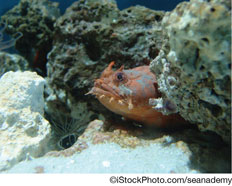

 One of the amazing things about life on the earth is that
life exists in places where the conditions are so severe that it would
seem impossible for any kind of life to be there. Imagine living in a
place where there is no sunlight, the temperature is slightly above
freezing, and pressure is greater than 150 tons per square foot. This
is the home of the deep sea anglerfish also known as the triplewart sea
devil and wolf-trap anglerfish. These names got applied when people
found dead specimens floating in the ocean and could not imagine what
they were like when they were alive. Now that scientists have seen them
in their natural environment, the awe of these creatures has just
gotten bigger.
One of the amazing things about life on the earth is that
life exists in places where the conditions are so severe that it would
seem impossible for any kind of life to be there. Imagine living in a
place where there is no sunlight, the temperature is slightly above
freezing, and pressure is greater than 150 tons per square foot. This
is the home of the deep sea anglerfish also known as the triplewart sea
devil and wolf-trap anglerfish. These names got applied when people
found dead specimens floating in the ocean and could not imagine what
they were like when they were alive. Now that scientists have seen them
in their natural environment, the awe of these creatures has just
gotten bigger.
Eating is a major issue for this fish. How do you locate food in
totally dark, sparsely populated regions of the sea? The deep sea
anglerfish has a rod running off its head with a light-giving enzyme
called luciferase on its tip. This enables the fish to attract prey
and/or mates. The tip is a fleshy wad that wiggles, looking like a
small fish. The jaw of the fish produces suction when the mouth is
opened and it has retractable teeth that face into the mouth. An
approaching fish will be sucked into the mouth and cannot get out. The
mouth can open in four milliseconds so the suction is very fast. The
stomach of the fish is expandable so it can actually swallow something
larger than itself.
Finding a mate is an issue in the conditions of the deep sea, but the
male anglerfish is 25 times smaller than the female, and when they find
each other he chomps down on the female and never lets go. His
circulatory system fuses with hers and all his organs except the
reproductive organs shut down, so he becomes a permanent sperm bank.
One species of anglerfish has a male that is 6.2 mm long, the smallest
vertebrate known to man.
One can propose that evolutionary change explains these incredible
adaptations to an alien environment, but we would suggest that
intelligence planned and designed this system so that life can exist
even in the deserts of the oceans. We can know there is a God through
the things He has made (Romans 1:20).
Source: Discover, June 2010,
page 20.
Back to Contents
Does God Exist? JanFeb11.



 One of the amazing things about life on the earth is that
life exists in places where the conditions are so severe that it would
seem impossible for any kind of life to be there. Imagine living in a
place where there is no sunlight, the temperature is slightly above
freezing, and pressure is greater than 150 tons per square foot. This
is the home of the deep sea anglerfish also known as the triplewart sea
devil and wolf-trap anglerfish. These names got applied when people
found dead specimens floating in the ocean and could not imagine what
they were like when they were alive. Now that scientists have seen them
in their natural environment, the awe of these creatures has just
gotten bigger.
One of the amazing things about life on the earth is that
life exists in places where the conditions are so severe that it would
seem impossible for any kind of life to be there. Imagine living in a
place where there is no sunlight, the temperature is slightly above
freezing, and pressure is greater than 150 tons per square foot. This
is the home of the deep sea anglerfish also known as the triplewart sea
devil and wolf-trap anglerfish. These names got applied when people
found dead specimens floating in the ocean and could not imagine what
they were like when they were alive. Now that scientists have seen them
in their natural environment, the awe of these creatures has just
gotten bigger.